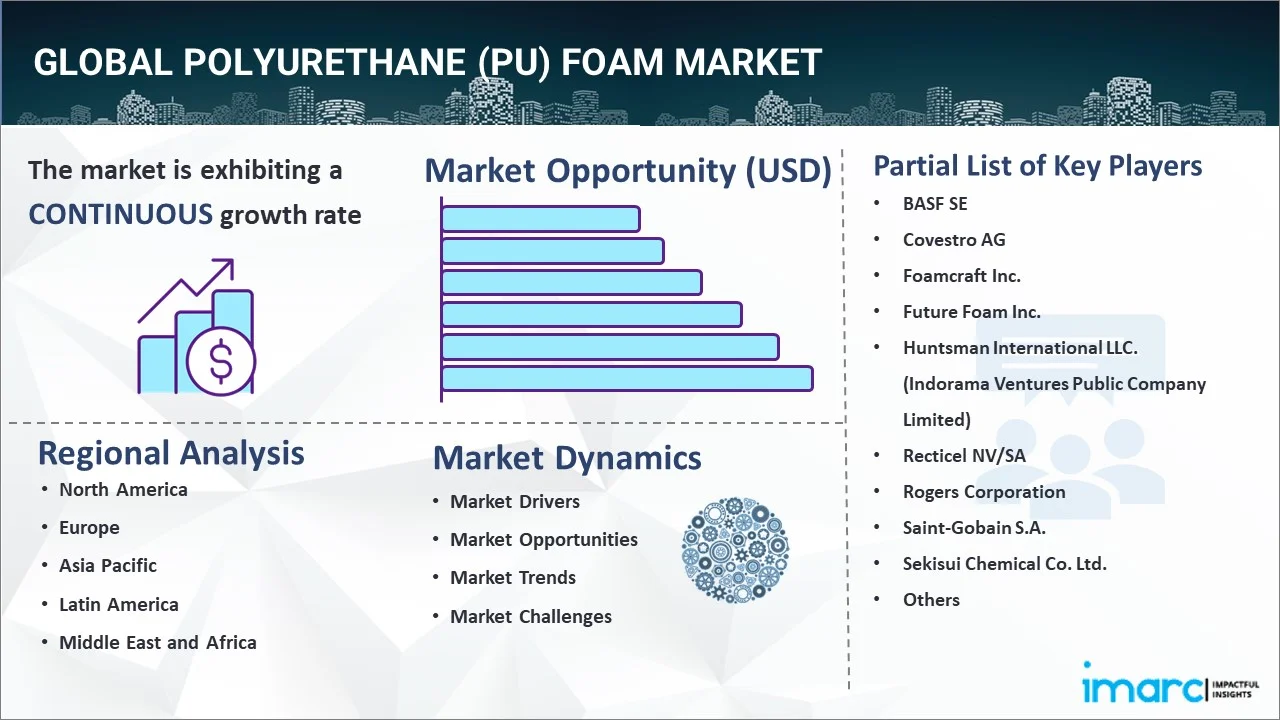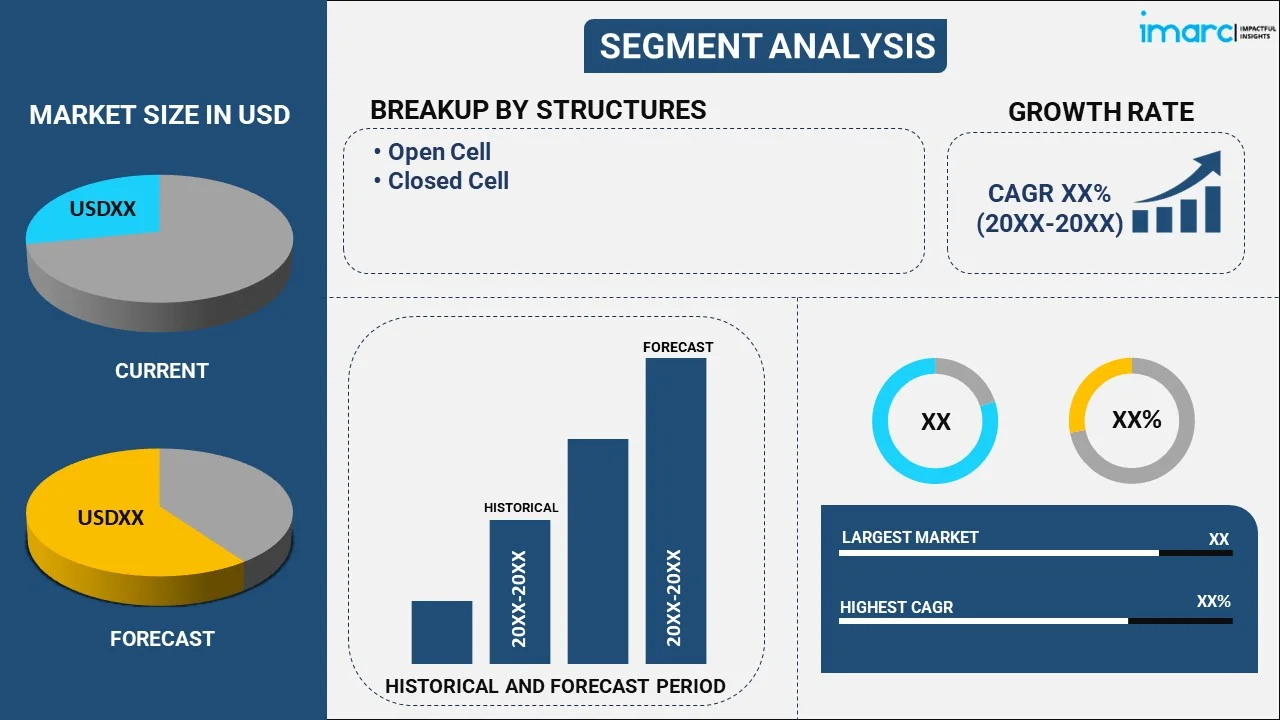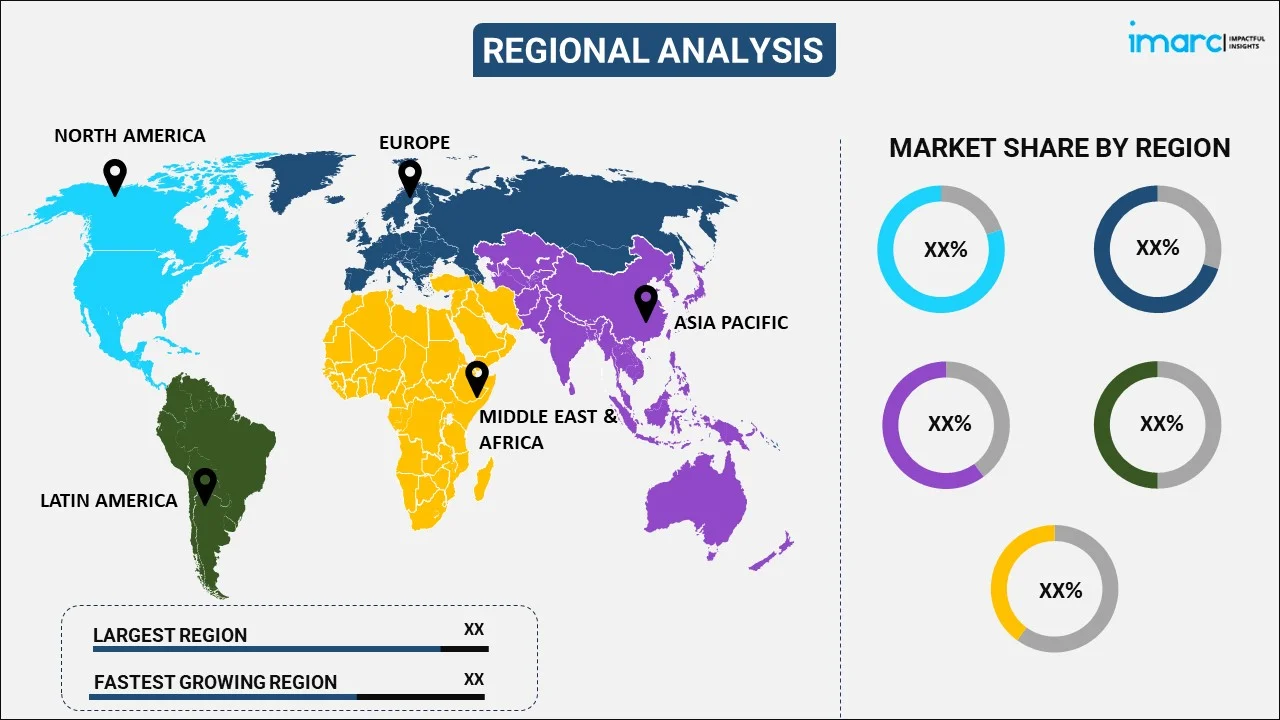
Polyurethane (PU) Foam Market Report by Structure (Open Cell, Closed Cell), Product Type (Flexible Foam, Rigid Foam, Spray Foam), Density (Low Density, Medium Density, High Density), End-Use Industry (Bedding and Furniture, Building and Construction, Electronics, Automotive, Packaging, Footwear, and Others), and Region 2025-2033
Global Polyurethane (PU) Foam Market:
The global polyurethane (PU) foam market size reached USD 55.1 Billion in 2024. Looking forward, IMARC Group expects the market to reach USD 89.8 Billion by 2033, exhibiting a growth rate (CAGR) of 5.57% during 2025-2033. The expanding construction industry, along with the introduction of bio-based polyols, is primarily driving the market demand. Further, the development of chemical and mechanical recycling methods to break down foam waste into reusable raw materials is opportunistic for market growth.
|
Report Attribute
|
Key Statistics
|
|---|---|
|
Base Year
|
2024
|
|
Forecast Years
|
2025-2033
|
|
Historical Years
|
2019-2024
|
|
Market Size in 2024
|
USD 55.1 Billion |
|
Market Forecast in 2033
|
USD 89.8 Billion |
| Market Growth Rate (2025-2033) | 5.57% |
Polyurethane (PU) Foam Market Analysis:
- Major Market Drivers: The rising demand for semi-rigid and flexible polyurethane foams that are used with paints, coatings, and adhesives in residential and commercial complexes is one of the key drivers stimulating the polyurethane (PU) foam market growth.
- Key Market Trends: Numerous product innovations for the manufacturing of light-weight automobile components, including armrests, dashboards, airbags, and other exterior parts, are acting as significant growth-inducing factors.
- Competitive Landscape: Some of the prominent companies in the global market include BASF SE, Covestro AG, Foamcraft Inc., Future Foam Inc., Huntsman International LLC. (Indorama Ventures Public Company Limited), Recticel NV/SA, Rogers Corporation, Saint-Gobain S.A., Sekisui Chemical Co. Ltd., The Dow Chemical Company, Tosoh Corporation, UFP Technologies Inc., and Wanhua Chemical Group Co. Ltd., among many others.
- Geographical Trends: Asia Pacific exhibits a clear dominance in the market, owing to its extensive investments in the packaging industry. Additionally, the easy availability of spray, flexible, and rigid forms is further bolstering the regional market.
- Challenges and Opportunities: One of the key challenges hindering the market is the increasing environmental concerns. However, the development of sustainable alternatives will continue to fuel the market over the forecasted period.

Polyurethane (PU) Foam Market Trends:
Introduction of Bio-based PU Foams
The rising popularity of bio-based alternatives that are derived from renewable resources like castor oil, soybeans, and other plant-based materials to minimize dependence on petroleum-based chemicals is propelling the market. Moreover, they not only lower the carbon footprint but also offer comparable performance to traditional foams. Companies are investing in R&D activities to enhance the properties of these sustainable foams, making them more competitive. Additionally, the growing consumer preference for eco-friendly products is further escalating the polyurethane (PU) foam market demand. For instance, in May 2024, Media Fusion and Crain Communications announced India's first sustainable Polyurethane and Foam Expo Show at NESCO, Bombay Exhibition Center, to bring together manufacturers and producers of PU materials, products, and technologies.
Improvements in Recycling Technologies
The development of chemical and mechanical recycling methods to break down foam waste into reusable raw materials is fueling the polyurethane (PU) foam market growth. These technologies enable high-quality recycled polyurethane foams, thereby minimizing the need for virgin materials and reducing waste. Moreover, the implementation of efficient recycling systems is becoming a priority for manufacturers to comply with environmental regulations and meet the increasing demand for sustainable practices in the industry, which is elevating the polyurethane (PU) foam market revenue. For example, in March 2024, Milliken & Company showcased a comprehensive colorant and additive portfolio designed to enhance polyurethane (PU) formulations that offer a higher recovery yield, thereby encouraging post-industrial and post-consumer usage without impacting the recycled polyol's color.
Increasing Applications in the Construction Industry
The construction industry utilizes these foams for sealants, thermal insulation, adhesives, etc., thereby enhancing energy efficiency and building durability. The lightweight nature of polyurethane foams also helps in reducing overall vehicle weight and improving fuel efficiency. As these industries continue to grow and prioritize performance and efficiency, the demand for high-quality product variants is expected to fuel the polyurethane (PU) foam market outlook over the forecasted period. For example, in May 2024, Wolf Group, the building chemicals producer and brand owner of Penosil spray, opened its PU foam factory in Spain for the construction processes.
Global Polyurethane (PU) Foam Industry Segmentation:
IMARC Group provides an analysis of the key trends in each segment of the market, along with the polyurethane (PU) foam market forecast at the global, regional, and country levels for 2025-2033. Our report has categorized the market based on the structure, product type, density, and end-use industry.
Breakup by Structure:

- Open Cell
- Closed Cell
The report has provided a detailed breakup and analysis of the market based on the structure. This includes open cell and closed cell.
Open cell PU foam, known for its softer and more flexible nature, is widely utilized in acoustic insulation, furniture, bedding, and packaging due to its excellent sound absorption and cushioning properties. In contrast, closed cell PU foam, which is denser and more rigid, excels in thermal insulation, buoyancy applications, and automotive uses owing to its superior thermal insulation, moisture resistance, and buoyancy. The polyurethane foam price trends are influenced by the increasing construction activities, the escalating demand for energy-efficient buildings, and the growth of the automotive sector.
Breakup by Product Type:
- Flexible Foam
- Rigid Foam
- Spray Foam
Currently, rigid foam holds the largest polyurethane (PU) foam market share
The report has provided a detailed breakup and analysis of the market based on the product type. This includes flexible foam, rigid foam, and spray foam. According to the report, rigid foam represented the largest market segmentation.
Rigid PU foam, characterized by its high insulation properties and structural integrity, continues to see significant advancements and product launches. Recently, several key players in the industry have introduced innovative rigid PU foam products aimed at enhancing energy efficiency and sustainability in construction and industrial applications. For instance, BASF launched a new line of rigid PU foam panels designed for superior thermal insulation in building envelopes, significantly reducing energy consumption. These product launches not only highlight the ongoing innovation within the rigid PU foam segment but also underscore the market’s response to increasing regulatory pressures and consumer demand for greener, more efficient building materials.
Breakup by Density:
- Low Density
- Medium Density
- High Density
Among these, low density account for the largest polyurethane (PU) foam market value
The report has provided a detailed breakup and analysis of the market based on the density. This includes low density, medium density, and high density. According to the report, low density represented the largest market segmentation.
Low density PU foam represented the largest segmentation in the market due to its extensive range of applications and cost-effectiveness. Its lower material usage results in significant cost savings, making it an attractive choice for manufacturers. This type of foam is widely used in the furniture and bedding industry for cushions and mattresses, where comfort and breathability are crucial. Additionally, its excellent sound absorption properties make it ideal for acoustic insulation in buildings and vehicles. The lightweight nature also contributes to its popularity in packaging applications, providing adequate protection while reducing shipping costs. As per the polyurethane (PU) foam market overview, these versatile applications, combined with economic advantages, will continue to fuel dominance in the coming years.
Breakup by End-Use Industry:
- Bedding and Furniture
- Building and Construction
- Electronics
- Automotive
- Packaging
- Footwear
- Others
Building and construction account for the majority of the total market share
The report has provided a detailed breakup and analysis of the market based on the end-use industry. This includes bedding and furniture, building and construction, electronics, automotive, packaging, footwear, and others. According to the report, building and construction represented the largest market segmentation.
The building and construction sector represented the largest segmentation in the market due to the material’s exceptional insulating properties, which are crucial for enhancing energy efficiency in buildings. Rigid PU foam is extensively used in insulation panels, roofing, and wall systems, providing superior thermal resistance that significantly reduces energy consumption and utility costs. The increasing emphasis on green building practices and stringent energy efficiency regulations have further fueled the demand for PU foam in construction. Moreover, PU foam’s lightweight nature and ease of installation make it a preferred choice for builders seeking to improve structural integrity and reduce construction time. The rapid urbanization and growing infrastructure projects globally have also contributed to the dominance of the building and construction sector in the polyurethane (PU) foam market segmentation. For example, in May 2024, Cannon Afros, part of the Cannon Group, launched the LIFE VICORPAN Project for the thermal insulation of domestic and commercial refrigerators using polyurethane (PU) resin-based formulations.
Breakup by Region:

- North America
- United States
- Canada
- Asia Pacific
- China
- Japan
- India
- South Korea
- Australia
- Indonesia
- Others
- Europe
- Germany
- France
- United Kingdom
- Italy
- Spain
- Russia
- Others
- Latin America
- Brazil
- Mexico
- Others
- Middle East and Africa
Asia Pacific currently dominates the market
The polyurethane (PU) foam market research report has also provided a comprehensive analysis of all the major regional markets, which include North America (the United States and Canada); Asia Pacific (China, Japan, India, South Korea, Australia, Indonesia, and others); Europe (Germany, France, the United Kingdom, Italy, Spain, Russia, and others); Latin America (Brazil, Mexico, and others); and the Middle East and Africa. According to the report, Asia Pacific accounted for the largest market share.
The Asia Pacific polyurethane (PU) foam market is experiencing significant growth, driven by rapid industrialization, urbanization, and a booming construction sector across the region. Countries like China, India, and Japan are at the forefront, with increasing demand for PU foam in various applications, such as building insulation, automotive interiors, furniture, and packaging. The market is further bolstered by the presence of numerous local and international manufacturers who are investing in advanced production technologies and sustainable practices. These factors, combined with supportive government policies promoting energy efficiency and sustainable development, are propelling the growth of the polyurethane (PU) foam market statistics in Asia Pacific. For instance, in May 2024, Media Fusion and Crain Communications announced India's first sustainable Polyurethane and Foam Expo Show at NESCO, Bombay Exhibition Center, to bring together manufacturers and producers of PU materials, products, and technologies.
Competitive Landscape:
The market research report has provided a comprehensive analysis of the competitive landscape. Detailed profiles of all major polyurethane (PU) foam companies have also been provided. Some of the key players in the market include:
- BASF SE
- Covestro AG
- Foamcraft Inc.
- Future Foam Inc.
- Huntsman International LLC. (Indorama Ventures Public Company Limited)
- Recticel NV/SA
- Rogers Corporation
- Saint-Gobain S.A.
- Sekisui Chemical Co. Ltd.
- The Dow Chemical Company
- Tosoh Corporation
- UFP Technologies Inc.
- Wanhua Chemical Group Co. Ltd.
(Please note that this is only a partial list of the key players, and the complete list is provided in the report.)
Polyurethane (PU) Foam Market Recent Developments:
- May 2024: Wolf Group, the building chemicals producer and brand owner of Penosil spray, opened its polyurethane (PU) foam factory in Spain for the construction processes.
- May 2024: Cannon Afros, part of the Cannon Group, launched the LIFE VICORPAN Project for the thermal insulation of domestic and commercial refrigerators using polyurethane (PU) resin-based formulations.
- March 2024: Milliken & Company showcased a comprehensive colorant and additive portfolio designed to enhance polyurethane (PU) formulations that offer a higher recovery yield without impacting the recycled polyol's color.
Polyurethane (PU) Foam Market Report Scope:
| Report Features | Details |
|---|---|
| Base Year of the Analysis | 2024 |
| Historical Period | 2019-2024 |
| Forecast Period | 2025-2033 |
| Units | Billion USD |
| Scope of the Report | Exploration of Historical Trends and Market Outlook, Industry Catalysts and Challenges, Segment-Wise Historical and Predictive Market Assessment:
|
| Structures Covered | Open Cell, Closed Cell |
| Product Types Covered | Flexible Foam, Rigid Foam, Spray Foam |
| Densities Covered | Low Density, Medium Density, High Density |
| End-Use Industries Covered | Bedding and Furniture, Building and Construction, Electronics, Automotive, Packaging, Footwear, Others |
| Regions Covered | Asia Pacific, Europe, North America, Latin America, Middle East and Africa |
| Countries Covered | United States, Canada, Germany, France, United Kingdom, Italy, Spain, Russia, China, Japan, India, South Korea, Australia, Indonesia, Brazil, Mexico |
| Companies Covered | BASF SE, Covestro AG, Foamcraft Inc., Future Foam Inc., Huntsman International LLC. (Indorama Ventures Public Company Limited), Recticel NV/SA, Rogers Corporation, Saint-Gobain S.A., Sekisui Chemical Co. Ltd., The Dow Chemical Company, Tosoh Corporation, UFP Technologies Inc., Wanhua Chemical Group Co. Ltd., etc. |
| Customization Scope | 10% Free Customization |
| Post-Sale Analyst Support | 10-12 Weeks |
| Delivery Format | PDF and Excel through Email (We can also provide the editable version of the report in PPT/Word format on special request) |
Key Benefits for Stakeholders:
- IMARC's industry report offers a comprehensive quantitative analysis of various market segments, historical and current market trends, market forecasts, and dynamics of the polyurethane (PU) foam market from 2019-2033.
- The research report provides the latest information on the market drivers, challenges, and opportunities in the global polyurethane (PU) foam market.
- The study maps the leading, as well as the fastest-growing, regional markets. It further enables stakeholders to identify the key country-level markets within each region.
- Porter's five forces analysis assists stakeholders in assessing the impact of new entrants, competitive rivalry, supplier power, buyer power, and the threat of substitution. It helps stakeholders to analyze the level of competition within the polyurethane (PU) foam industry and its attractiveness.
- The competitive landscape allows stakeholders to understand their competitive environment and provides insight into the current positions of key players in the market.
Key Questions Answered in This Report
The global polyurethane (PU) foam market was valued at USD 55.1 Billion in 2024.
We expect the global polyurethane (PU) foam market to exhibit a CAGR of 5.57% during 2025-2033.
The growing adoption of flexible and semi-rigid polyurethane foams for coatings, paints, and adhesives across residential and commercial complexes is primarily driving the global polyurethane (PU) foam market growth.
The sudden outbreak of the COVID-19 pandemic had led to the implementation of stringent lockdown regulations across several nations, resulting in the temporary halt in numerous construction activities, thereby negatively impacting the demand for polyurethane (PU) foam.
Based on the product type, the global polyurethane (PU) foam market can be categorized into flexible foam, rigid foam, and spray foam. Currently, rigid foam exhibits a clear dominance in the market.
Based on the density, the global polyurethane (PU) foam market has been segmented into low density, medium density, and high density. Among these, low density currently represents the largest market share.
Based on the end-use industry, the global polyurethane (PU) foam market can be bifurcated into bedding and furniture, building and construction, electronics, automotive, packaging, footwear, and others. Currently, the building and construction industry accounts for the majority of the total market share.
On a regional level, the market has been classified into North America, Europe, Asia Pacific, Middle East and Africa, and Latin America, where Asia Pacific currently dominates the global market.
Some of the major players in the global polyurethane (PU) foam market include BASF SE, Covestro AG, Foamcraft Inc., Future Foam Inc., Huntsman International LLC. (Indorama Ventures Public Company Limited), Recticel NV/SA, Rogers Corporation, Saint-Gobain S.A., Sekisui Chemical Co. Ltd., The Dow Chemical Company, Tosoh Corporation, UFP Technologies Inc., Wanhua Chemical Group Co. Ltd., etc.
Need more help?
- Speak to our experienced analysts for insights on the current market scenarios.
- Include additional segments and countries to customize the report as per your requirement.
- Gain an unparalleled competitive advantage in your domain by understanding how to utilize the report and positively impacting your operations and revenue.
- For further assistance, please connect with our analysts.

 Inquire Before Buying
Inquire Before Buying
 Speak to an Analyst
Speak to an Analyst
 Request Brochure
Request Brochure
 Request Customization
Request Customization



.webp)




.webp)












